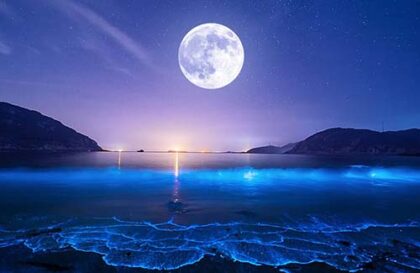On the Moon, moonquakes can reach magnitudes of up to 5.5 on the Richter scale. (An earthquake of magnitude 5.5 on the Richter scale is classified as a “moderate” earthquake. Such earthquakes can cause damage to poorly constructed buildings and structures.) Moonquakes are caused by tidal forces, moving soils, and meteorites. They pose a danger to possible stations on the Moon.
During the flights to the Moon, the USA delivered 380 kg of soil to Earth, and the USSR – 324 kg. The Americans distributed some of the samples for research to scientific organizations in the USA, Europe, Asia, and Australia. All fragments of lunar rock differ sharply in composition from terrestrial substances.
Left: Apollo 11 basalt 10049. This sample has a mass of 193 grams. The ruler scale is in centimeters. Right: Apollo 11 breccia 10018. This sample has a mass of 213 grams and is up to 8 centimeters across. Credit: Lunar and Planetary Institute
The Earth’s satellite is 4.5 billion years old. It is believed that the Moon was formed after the Earth collided with an object the size of Mars from matter molten from the impact. Research by the Massachusetts Institute of Technology on moon rocks in the 1970s showed that the Moon had a magnetic field. In 2009, NASA discovered water on the Moon, measuring its volume at 600 million tons. Water has been found in more than 40 craters.
The Sun is 400 times larger than the Moon, but the Moon is 400 times closer to the Earth than the Sun. Despite the Sun’s greater gravity, the Moon’s tidal forces are twice as strong. Sea tides from the Moon are more assertive on the eastern coasts of continents. The maximum tide in the Bay of Fundy Canada is almost 20 yards (18 m).
The Moon completes one orbit around the Earth every 27.3 days, the same amount of time it takes to rotate on its axis, so we always see the same side of the Moon. But the average solar day on the Moon is equal to the average synodic month (the average interval between two identical phases of the Moon, for example, full moons) – 29 days, 12 hours, 44 minutes, 2.82 seconds.
Thus, the day lasts almost 15 days, and the night lasts nearly 15 days.
Due to the absence of a dense atmosphere on the surface of the Moon, the temperature is +127 °C in an illuminated place during the day and drops sharply within one hour by 150 °C after sunset. At night, the temperature reaches −173 °C. The same thing happens with the appearance of the first rays of the Sun. The temperature rises sharply and, within 15-30 minutes, already reaches above + 100 degrees. In this case, the rocks’ temperature at a depth of 1 m is constant and equal to −35 °C.
It has been established that at the South Pole it can drop to -238°C. In craters at the North Pole, it can drop to -247°C.
There is practically no atmospheric pressure on the Moon. It is approximately 10 nPa or 1/(1,000,000,000,00000 – one hundred trillionth) of normal pressure on Earth. The absence of an atmosphere leads to the fact that there is no sunrise and sunset, no morning and evening on the Moon. There are only two times of day – day and night.
The sky on the Moon is always black and full of stars, even when the Sun is above the horizon.
If we observe the Moon from the North Pole, we will see that it rotates counterclockwise from west to east. The average rotation speed around the Earth reaches 2289 mph (3683 km/h), and the complete route around our planet is 1.744 million miles (2.29 million km).
The Moon does not wax or wane; its outlines are hidden in the shadows, and we see only the part illuminated by the Sun. The lunar cycle is 29.5 days: how much time passes from one new moon to the next (from full moon to full moon). We see not 50%, but 59% of the Moon’s surface. This is due to the different angular speeds of our satellites at the near and far points of the orbit.
The Moon is fully visible when it is on the opposite side of the Earth from the Sun: it is at this time that we see the full moon. Two full moons per month are rarely visible, once every 2.7 years, in which case the second full moon is called a blue moon. Lunar eclipses occur when the Earth’s shadow falls on the Moon, and solar eclipses occur when the Moon comes between the Earth and the Sun and blocks the luminary from view. These phenomena result from a striking coincidence and are the subject of astronomers’ delight.
The moon moves around our planet in an elliptical orbit. The distance to it varies from 356,400 km to 406,700 km. Approximately once every 13 months, a full moon occurs at perigee – the closest point to the Earth relative to its orbit. At this point, the Moon appears 15% larger and 30% brighter than at apogee, the farthest point in its orbit. This phenomenon is called a supermoon.
Banner image: Royal Museums Greenwich / Author Giorgia Hofer, Astronomy Photographer
Image credit:
https://www.rmg.co.uk
https://www.lpi.usra.edu
https://taylorsciencegeeks.weebly.com






